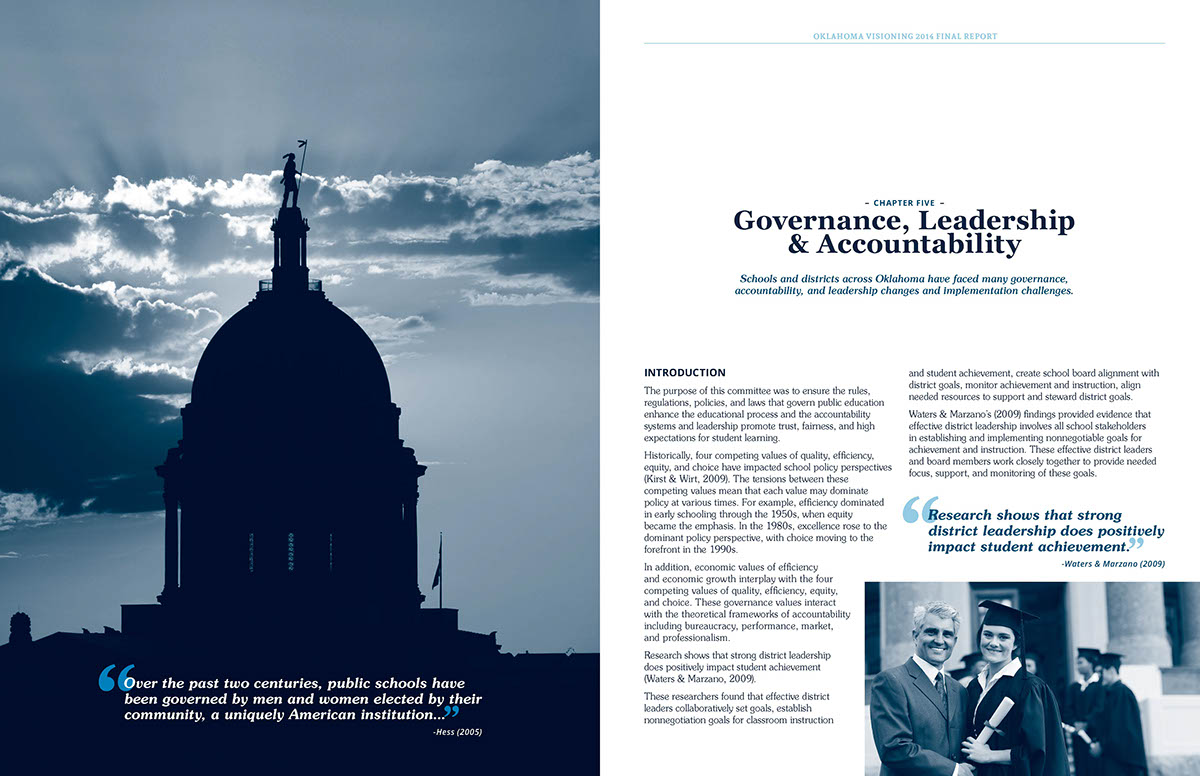- THE -
OKLAHOMA
VISIONING REPORT
The Oklahoma Visioning Project began in 2012 as a collaborative effort between the K20 Center for Educational and Community Renewal (the K20 Center), the Cooperative Council for Oklahoma School Administration (CCOSA), and the Oklahoma State School Boards Association. These powerful Oklahoma entities sought to take a proactive lead in state and national discussions about the future direction of public education. In the pursuit of this goal, they gathered 50 administrators and school board members from across the state, forming them into seven committees. Each committee would focus on one facet of this report.

In November of 2013, my team and I were tasked with creating a consistent and cohesive design that would bind three large elements (the final report, executive summary and website) of OK Visioning together into an approachable format that would efficiently communicate important information, no matter the audience or the delivery method. Our targets were identified as school administrators and teachers, business and community leaders, and legislators. Secondary targets were identified as parents and students.

Selecting a palette composed of two spot colors-one bright and highly saturated, and one dark enough to approximate black-gave us a wide range of color options well-suited to the complexity of the document.
OK Visioning's Project Lead, Shayna Pond, and I worked together to review and research the information from all seven committee reports, to locate statistics and develop infographics, and to develop a plan for design production that would minimize production costs for CCOSA and OSSBA-an essential requirement communicated by each client. We worked with several local printers to modify our design execution for the most cost efficient option possible. We determined that a two-color interior, utilizing spot colors, would sufficiently reduce costs.
At this point, I was provided with the final content for the document, allowing me to place content and begin building visual elements.

Each chapter included a variety of visual elements to help break up the dense body copy. Infographics, pull quotes and subtitles offered opportunities for the addition of color, creating visual interest.
I worked with a simple goal in mind:
Look for content patterns that will transition well to visual elements, helping readers to quickly discover important information.
Look for content patterns that will transition well to visual elements, helping readers to quickly discover important information.

Photography was carefully selected and converted to duotone. Once placed, a mixed ink was created from our pre-existing spot colors-to add more variety to more demanding layouts, such as the spread seen above.
To simplify the design process and ensure continuity, I used InDesign to create a document with several master page styles and a wide and flexible variety of paragraph, character and object styles. Those styles that were used most often included assigned shortcuts. Photography was selected by chapter and closely aligned with each chapter's key issues.
Once the content was placed and the majority of visual elements were added, I collaborated with the Project Lead to identify and satisfy opportunities for placement of infographics in each chapter.

From receipt of the final copy to completion of a press-ready file, this Oklahoma Visioning 2014 Final Report took approximately six weeks.










